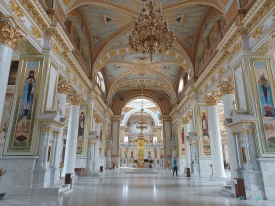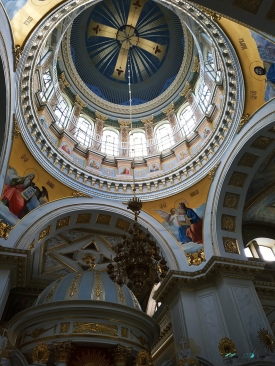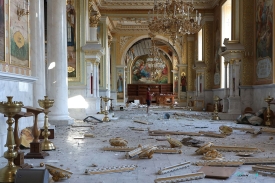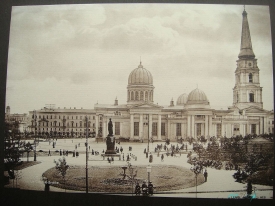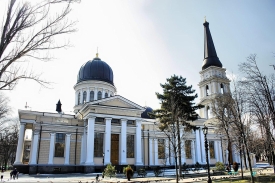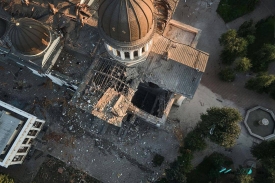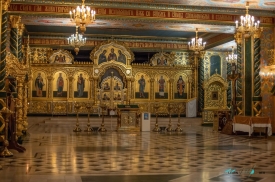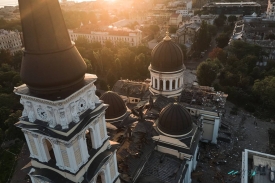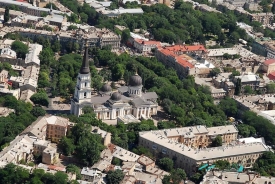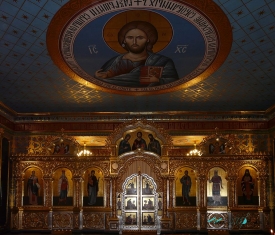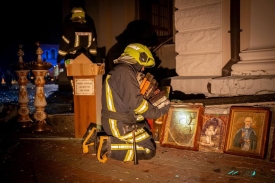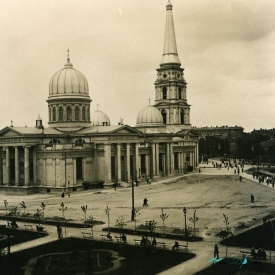The Spaso-Preobrazhenskyi Cathedral, also known as the Transfiguration Cathedral, has been a symbol of faith, history, and resilience in the city of Odessa. Founded by Tsarina Catherine the Great in 1795 and dedicated to the Transfiguration of Christ, the cathedral's rich history is a testament to the strength of the Ukrainian Orthodox Church and the enduring spirit of its people.
The 20th century brought turmoil and destruction to the cathedral. In 1919, during the establishment of the Soviet regime, the cathedral faced looting and was later closed in 1932. The darkest hour came in 1936 when Josef Stalin ordered its demolition, and the cathedral was tragically blown up during the night. The destruction devastated the local community and erased a significant piece of Ukraine's cultural heritage.
In 1999, a momentous reconstruction project began, spearheaded by the charitable organization "Black Sea Orthodox Fund." Generous donations from local entrepreneurs, citizens, and even foreigners poured in, surpassing 615 million dollars. This outpouring of support demonstrated the significance of the cathedral and its place in the hearts of the people.
As the people of Odessa gather their strength to rebuild once more, the Spaso-Preobrazhenskyi Cathedral stands as a testament to the power of unity, hope, and determination in the face of adversity. The cathedral will forever be a beacon of light, guiding the hearts of those who seek solace and inspiration in times of darkness.
A Visionary Beginning
The foundation of the Spaso-Preobrazhenskyi Cathedral was laid in 1795, but due to various challenges, including the interruption of construction during Catherine's son Paul's reign, the completion was delayed. It wasn't until Governor Voronzow took charge that the construction gained momentum again. The cathedral's bell tower, an architectural masterpiece designed by Italian master builders Giuseppe and Gian Torricelli, was a notable addition during this time.A Jewel of Odessa
By 1827, the Spaso-Preobrazhenskyi Cathedral stood tall, boasting a free-standing bell tower and intricate marble polychrome interiors. Over the course of the 19th century, significant renovations and expansions transformed the cathedral into one of the largest Orthodox cathedrals, with a capacity to accommodate up to 9000 people. Its grandeur and religious significance made it a jewel of Odessa's architectural landscape.The Dark Days of Destruction
The 20th century brought turmoil and destruction to the cathedral. In 1919, during the establishment of the Soviet regime, the cathedral faced looting and was later closed in 1932. The darkest hour came in 1936 when Josef Stalin ordered its demolition, and the cathedral was tragically blown up during the night. The destruction devastated the local community and erased a significant piece of Ukraine's cultural heritage.
A Beacon of Hope: The Reconstruction
Despite the decades of Soviet rule and the cathedral's tragic fate, the resilience of the Ukrainian people prevailed. During the Romanian rule in Odessa in World War II, discussions arose regarding the potential reconstruction of the cathedral, but it wasn't until after the fall of the Soviet Union that serious efforts began.In 1999, a momentous reconstruction project began, spearheaded by the charitable organization "Black Sea Orthodox Fund." Generous donations from local entrepreneurs, citizens, and even foreigners poured in, surpassing 615 million dollars. This outpouring of support demonstrated the significance of the cathedral and its place in the hearts of the people.
A Triumphant Return
After years of dedicated reconstruction efforts, the Spaso-Preobrazhenskyi Cathedral rose once again, faithful to its original design. On July 21, 2010, a joyous moment arrived as the newly rebuilt cathedral was consecrated by the Patriarch Kirill of Moscow and All Russia. The occasion was also marked by a generous gift from Greece ŌĆō 23 bells that now resonate from the cathedral's largest bell tower in Ukraine.Resilience Tested
However, the cathedral's journey was not without its trials. The night of July 23, 2023, saw a devastating event during the Russian invasion of Ukraine. Russian forces targeted the city of Odessa, launching missiles at various locations, including the Spaso-Preobrazhenskyi Cathedral. The airstrikes resulted in the partial destruction of the cathedral, causing immense grief and pain for the local community.A Symbol of Strength
Despite the recent devastation, the Spaso-Preobrazhenskyi Cathedral remains a symbol of strength, faith, and the indomitable spirit of the Ukrainian people. The cathedral's history, from its visionary inception to its destruction and subsequent reconstruction, embodies the country's enduring resolve to protect its cultural heritage and embrace its religious roots.As the people of Odessa gather their strength to rebuild once more, the Spaso-Preobrazhenskyi Cathedral stands as a testament to the power of unity, hope, and determination in the face of adversity. The cathedral will forever be a beacon of light, guiding the hearts of those who seek solace and inspiration in times of darkness.



